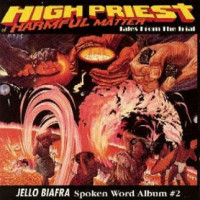High Priest of Harmful Matter: Tales from the Trial serves as a document of one of the most important moments in punk rock. After the release of Dead Kennedys’ Frankenchrist, Jello Biafra found police forcing their way into his house, tearing up his belongings, going through his phone book, and interrogating the artist. And why? Because the band included a painting by world famous artist H.R.. Giger in their album. Because Penis Landscape featured images of private parts- In a clearly non-sexual manner, mind you- the Los Angeles District Attorney Office was charging Biafra and a few other people in the supply chain with the distribution of obscenity.
Throughout the release’s second half, Biafra told the tale of the arrest, the trial, and the eventual dismissal of the charges. Biafra did pause here and there for his usual brand of sardonic humor. But, perhaps because the issue hit him directly, his detail here was more fact accounting then it was orchestration- and perhaps it was because a story as crazy as this didn’t need any peppering. How could a person be charged with a crime for simply putting art on a record?
But, Biafra was and on the release, he opened up about his own fears of what might happen to him. He switched back and forth form the position of First Amendment Defender and punk rocker attacking the normies. And frankly, both positions found Biafra as the one in the right. Biafra can be accused of spinning some topics to his benefit, but here, facts were facts, and admirably, Biafra stuck to his guns and didn’t back down, even when facing a year in prison.
Although the trial cost Biafra nearly one hundred thousand dollars, it was nice to get a happy ending. Eventually, despite its initial shortcomings, justice did prevail and the Judge dismissed the case, recognizing how out of control the DA’s office was. Despite the fact that his neck was on the chopping block, Biafra was able to tell the moral of the story without trying to make himself look like a hero. Rather, instead of investigating how he prevailed, he investigated the dangers of constriction of expression- something that both sides of the political spectrum seem to be dabbling in, recently.
Meanwhile, the release’s first half dealt more in the traditional Biafra spoken word style. Biafra switched from news reporter to cartoon character at the drop of a hat, acting the parts as much as talking about them. At nearly two hours, the release could have run drive, but Biafra was such a captivating speaker, the release almost felt more like entertainment than education. Not an easy thing to do when talking about the destruction of American freedom itself.
